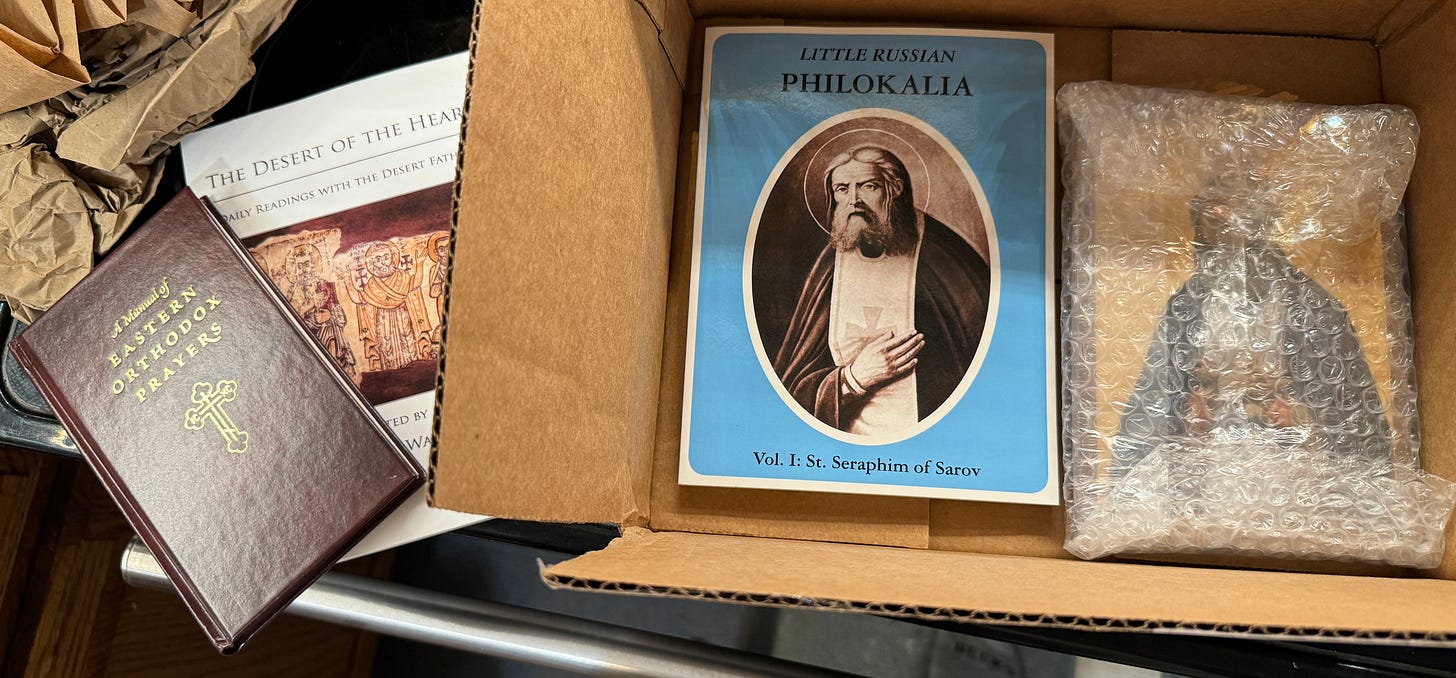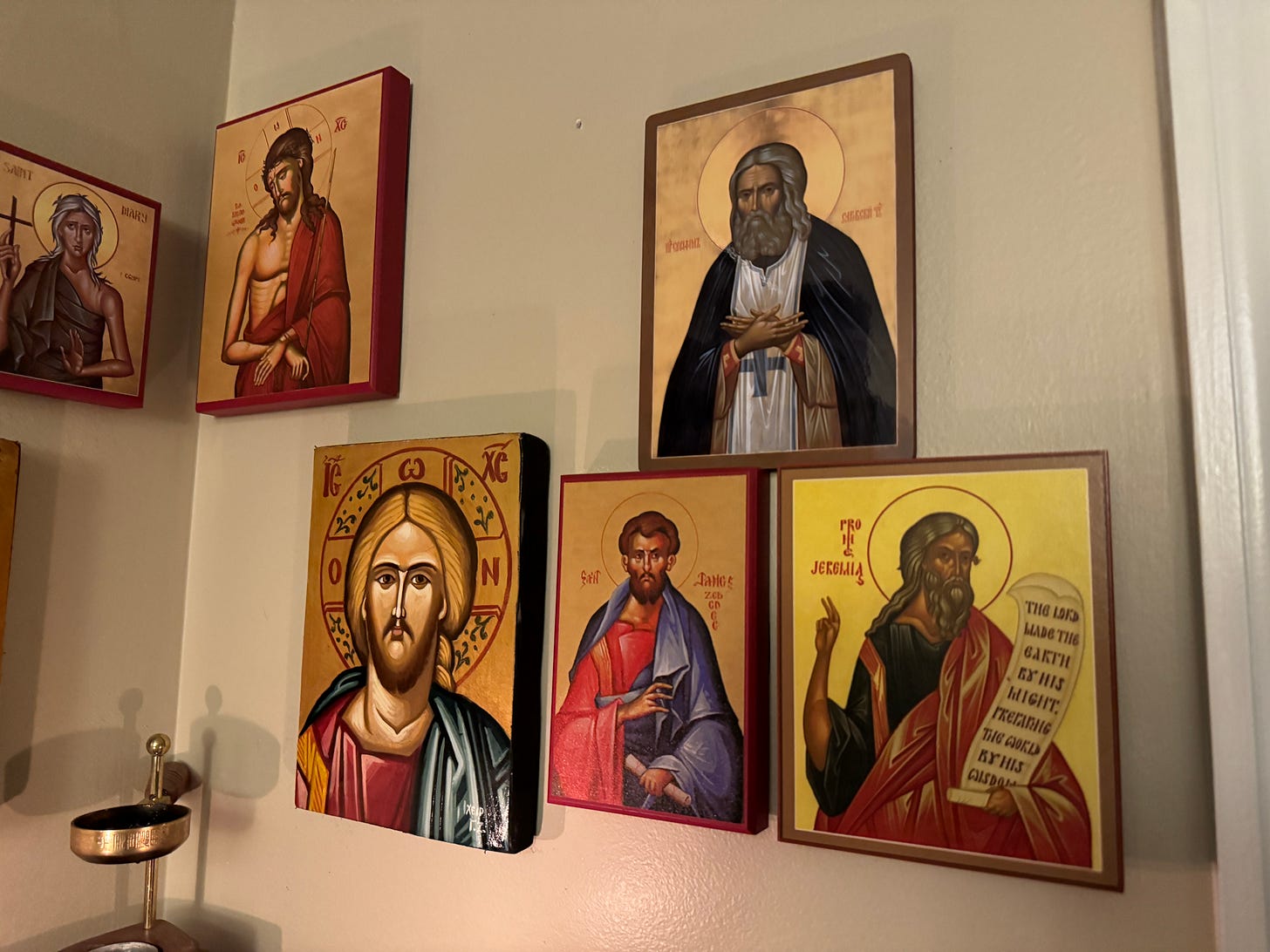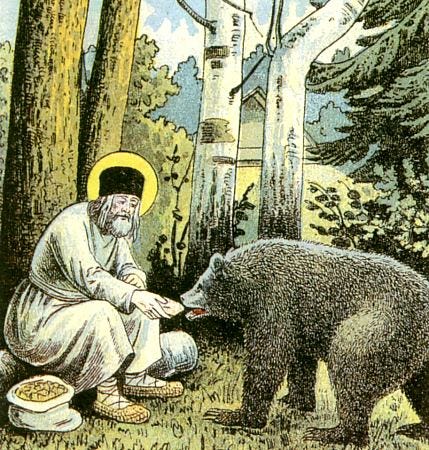The Calling of St. Seraphim
Sometimes you pick a saint, but sometimes the saint picks you.
Many of you have asked for my take on the state of the United States heading into the 2024 election. That is coming very soon—I have a long, angry, rambly draft that just needs a little polishing. It will admittedly be pretty dark and likely make you angry. But first, I wanted to offer a bit of brightness by discussing an amazing experience that recently happened to me.
I’ve admittedly been pretty blackpilled lately. The world seems more deranged by the day, everything is unbelievably expensive, and my family keeps being struck by waves of illness and injury.
For the past year, my family has been attending an Eastern Orthodox Church, and, God willing, we will be received into it soon. My weekly time in liturgy and fellowship with our new church family has been my weekly bright spot in an otherwise dark world.
But I had been questioning that decision recently. When a string of misfortune befalls us, I tend to look for the spiritual message, and it’s often difficult to tell if we’re on the wrong path, and God is trying to correct us, or if we’re headed in the right direction and the forces of evil are trying to discourage us.
But recently, the Lord sent me a very clear signal. One of the decisions we must make before joining the Church is choosing patron saints for ourselves and our children. Patron saints are a big deal in the Orthodox world since you are often called by your saint’s name in church, especially when you present yourself for communion.
My spiritual father had advised me to stick with the saint I’m named after—St. Joshua from the Bible—unless I had a strong calling to another saint, and although I don’t feel any strong connection to St. Joshua, I didn’t feel drawn to another.
However, many Orthodox Christians will tell you that oftentimes a saint will pick you. I didn’t know what that meant.
Until recently.
(Enjoy wild stories like this? Join Unprepared.life for weird stories of spirituality and rural living, along with survival guides on everything from emergency food kits to nuclear war.)
Mix-Up or Divine Providence?
Last week, I ordered more incense for our icon corner from Holy Cross Monastery in West Virginia. On Friday, the box arrived, I opened it up and found… absolutely no incense.
Instead, the box contained:
A copy of Manual of Eastern Orthodox Prayers (a prayer book)
A copy of The Desert of the Heart: Daily Readings with the Desert Fathers
I was greatly puzzled and amused. Then, curious, I picked up the Manual of Eastern Orthodox Prayers and looked to see what the morning prayers looked like. At the very beginning is a prayer rule devised by St. Seraphim of Sarov1.
At this point, I was spooked, but figured the other guy is just a big fan of St. Seraphim of Sarov, a famous Russian saint of the 18th and 19th centuries, most notable for saying, “Acquire a peaceful spirit, and around you thousands will be saved.”
The Tattoo Artist and the Clairvoyant Hieromonk
I found the invoice inside and an email address for the intended recipient, a Francis Khuu in Virginia. As it turns out, Francis is a famous tattoo artist with over 44,000 Instagram followers. I’ve never been a tattoo guy, but our church’s subdeacon is covered in them, so I asked if he had heard of Francis, and not only had he heard of him, he dreams of one day getting a tattoo from him. Wild.
So I email the monastery and Francis to let them know and ask what to do. At the end of the message, I added:
I'm scheduled to be received into the Church the day before Pascha and I've been discerning patron saints. Perhaps this is a sign?
The hieromonk (a monk that is also ordained as a priest) said this in his response:
St. Seraphim was known to say "Christ is risen my joy" at any time of the year to those who were having hard times. God help you on your way to being received into Holy Orthodoxy.
I had not mentioned any hard times in my email! How did he know to say that?
Wretched Seraphim
But Orthodoxy teaches us to be suspicious of spiritual experiences. We could easily be deceiving ourselves or be deceived by evil forces who want to trick us. It is often said that if we get a notion that something is God’s will or see a spirit that presents itself as an angel or saint, we should perform the sign of the cross and tell it to go away. Orthodoxy has a reputation for mysticism, but it’s very grounded in its suspicions of the supernatural.
So I messaged my spiritual father and my presumptive godfather, who has been trained as a priest but not ordained. My spiritual father didn’t deny that it could be a sign. My godfather said, yes, it’s absolutely a sign and that he was going to start calling me Seraphim.
Seraphim is a most holy name. In the Bible, a seraphim is a type of angel, and it’s the adopted namesake of St. Seraphim of Sarov and Fr. Seraphim Rose, the latter being one of the most popular Orthodox authors of the past few decades (we mentioned the late Fr. Rose when discussing UFOS).
So I replied to my godfather, “Too holy a name for my wretched soul.”
Later, I decided to look up St. Seraphim of Sarov in The Prologue from Ohrid, a compendium of saints’ lives compiled by St. Nikolaj Velimirović. St. Seraphim’s entry is baffingly short for such a popular saint. Here it is in its entirety:
Seraphim was one of the greatest Russian ascetics, discerners and miracle-workers. He was born in 1759 A.D and died in 1833 A.D. Seraphim was distinguished by great humility. When the entire world praised him, he referred to himself as “the wretched Seraphim.”
Whoa.
To add a cherry on top of all of this weirdness, the next day my godfather was photographing a wedding at an Episcopalian Church and, inside, he took this photo of an iconostasis of icons of… you guessed it.
A Happy Ending
Meanwhile, my new friend Francis was understandably fretting about his stuff. Thankfully, that ultimately turned out to not be a problem because he ended up getting his stuff the day after I had got his stuff.
I decided that clearly these things had been intended for me and asked the monastery to send me an invoice, which I was happy to pay. Now St. Seraphim looks down at me from my icon corner, I’m readily studying his writings, and praying from my new prayer manual.
It’s possible to examine these events through a skeptical lens. Perhaps it really was just a mistake and now I’m subconsciously seeking signs? Maybe, but really, I just wanted some incense and to clear up the mistake. What followed by pure kismet.
But personally, I take it as a sign from God that while things are difficult now, I am moving in the right direction. Thankfully He knows me enough to know that I am thickheaded and don’t take hints well, so he has beat me over the head with his signs.
And from this happy accident, I have been greatly blessed with a new patron saint and spiritual role model, and my new friend Francis whom I must go meet one day.
I’ve never been a fan of tattoos, but perhaps this is a sign I should get one? After all, I’m 40 now, and I’m due for a midlife crisis. What should I get one of? While the Eastern Orthodox are not in communion with the Coptic Orthodox, I’ve always respect the Coptic practice of tattooing themselves with a cross, even when living in areas where there are serious repercussions for being a Christian.
Or perhaps I should get a tattoo of St. Seraphim? With my spiritual father’s blessing, of course.
Interestingly, the prayer rule of St. Seraphim of Sarov in this book is very different than the prayer rule he popularized, which simply consists of 3 Our Fathers, 3 Orthodox variants of the Hail Mary, and the Nicene Creed. The prayer rule presented in Manual of Eastern Orthodox Prayers consists of 8 variations of the Jesus Prayer, separated by prostrations.







